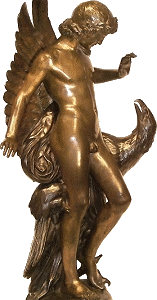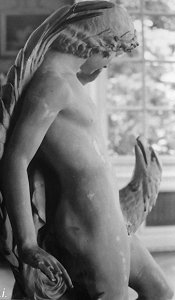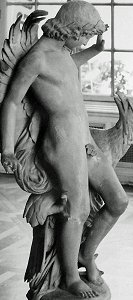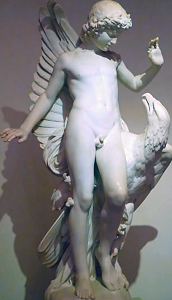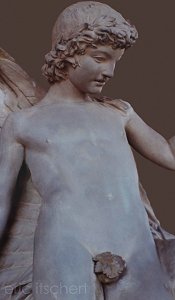
Site Introduction | Art Gallery Index
Falguière and Moulin Page | Falguière Page | View Pictures
![]() Hippolyte-Alexandre
Hippolyte-Alexandre
Julien Moulin
(1832-1884)
Ganymede, A Secret from On High
and A Find at Pompeii
Moulin’s Find at Pompeii is one of several male statues featured in my adult story “On Display”. Do not follow this link if you find sexual content offensive.
View pictures of Ganymede
View pictures of A Secret from On High
View Pictures of A Lucky Find at Pompeii
“The Son of a poor shopkeeper, Hippolyte Moulin entered the Ecole des Beaux-Arts in 1855 but, for financial reasons, was soon forced to stop attending classes. To earn a living he gave language lessons at pensions in the Marais district of Paris. Although he studied with Auguste-Louis-Marie Ottin and with Barye, for the most part Moulin seems to have been self-taught. He made his Salon debut in 1857 and obtained his first success with a bronze, A Lucky Find at Pompeii, which won a medal at the Salon of 1864. Moulin continued exhibiting at the Salon until 1877, winning medals in 1867, 1869, and at the Exposition Universelle of 1878.
He received a number of State commissions; the most important were a Statue of Victoria Mars (plaster exhibited at the Salon of 1872) [I have not been able to find an image of this work - Leem] and A Secret from On High [below] (plaster exhibited at the Salon of 1873; marble exhibited at the Salon of 1875 [and now in the Musée d’Orsay. This statue depicts Mercury (Hermes) whispering a secret to a “herm” - a column topped with a bust of himself - either knowing that it will never repeat what he tells it, or because he intends it to repeat what he says. Pictured on this page are the original marble nude and some variously-patinated bronze statuettes with fig leaves or drapery added. Copies of the statue have been seen as television props on I, Claudius (masquerading as an ancient Roman statue), and on an episode of Father Brown]. This latter work, as well as A Lucky Find at Pompeii, is an inventive and amusing pastiche of antique statuary. Moulin spent the last years of his life in a rest home for the mentally ill.
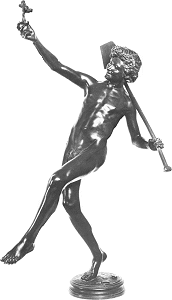 A Lucky Find at Pompeii [left: statuette] is probably Moulin’s best-known work. A life-size bronze version, signed and dated 1863, was exhibited and won a medal at the Salon of 1864; the same year it was purchased by the State for 7,000 francs; in 1867, it was included at the Exposition Universelle. Part of the Musée du Luxembourg collection during the nineteenth century, and [subsequently exhibited] in the Louvre, [the life-size bronze is now in the Musée d’Orsay, although there is no image of it on the Orsay website.] Reviewing the Salon of 1864, the critic Léon Lagrange remarked that all the best statues of that year were balanced on one foot. While certain of these works, such as Falguière’s Winner of the Cockfight [which today stands on a tall pedestal alongside Moulin’s Lucky Find in the Musée d’Orsay], adopted the pose of Giambologna’s Mercury, Moulin’s figure was inspired by the famous antique Dancing Faun from Pompeii (original in Museo Archeologico Nazionale, Naples).
A Lucky Find at Pompeii [left: statuette] is probably Moulin’s best-known work. A life-size bronze version, signed and dated 1863, was exhibited and won a medal at the Salon of 1864; the same year it was purchased by the State for 7,000 francs; in 1867, it was included at the Exposition Universelle. Part of the Musée du Luxembourg collection during the nineteenth century, and [subsequently exhibited] in the Louvre, [the life-size bronze is now in the Musée d’Orsay, although there is no image of it on the Orsay website.] Reviewing the Salon of 1864, the critic Léon Lagrange remarked that all the best statues of that year were balanced on one foot. While certain of these works, such as Falguière’s Winner of the Cockfight [which today stands on a tall pedestal alongside Moulin’s Lucky Find in the Musée d’Orsay], adopted the pose of Giambologna’s Mercury, Moulin’s figure was inspired by the famous antique Dancing Faun from Pompeii (original in Museo Archeologico Nazionale, Naples).
[Another statue which uses an almost identical pose is the American Frederick MacMonnies’ female nude, Bacchante and Infant Faun (1895), which caused considerable controversy when it was installed at the Boston Public Library: follow this link for more details.]
Moulin’s figure also grows out of nineteenth-century tradition which includes Duret’s Dancing Neapolitan Boy. Somewhat contrived, both in pose and in subject, A Lucky Find at Pompeii combines several elements - an adolescent, a movemented, unconventional pose, and an exotic genre subject - that recur continually in Salon sculpture of the period.”
- Adapted from The Romantics to Rodin by Peter Fusco and H.W. Janson
[text in brackets comprises additional material and updates by Leem]
Return to beginning of Artist Biography
Images of Moulin’s Ganymede: a bronze statuette and the marble in the Musée des Beaux-Arts de Béziers
Broken links in this section are fixed as of March 2023
Images of Moulin’s Secret d’en Haut (A Secret from On High) and Une Trouvaille a Pompeii (A Lucky Find at Pompeii):
The original life-size nudes are in the Musée d’Orsay, Paris. Unfortunately there are no images of Moulin’s work on the Orsay website. Most of the pictures on this page are ‘lucky finds’ from books or the web. These are the best images I’ve been able to obtain so far. Thanks to Anonymous Benefactor for supplying some additional images (September 2006). If you know where I can find even more I’d still be delighted to hear from you!!!
Secret D’en Haut:
Original marble in the Musée d’Orsay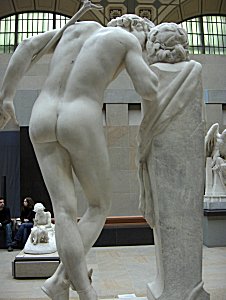
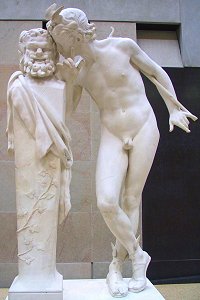
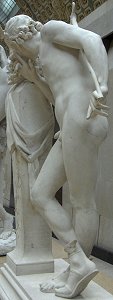
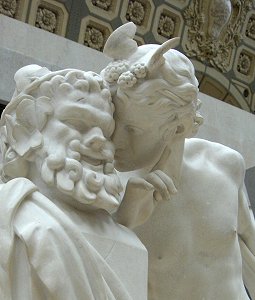
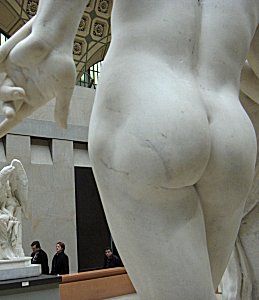
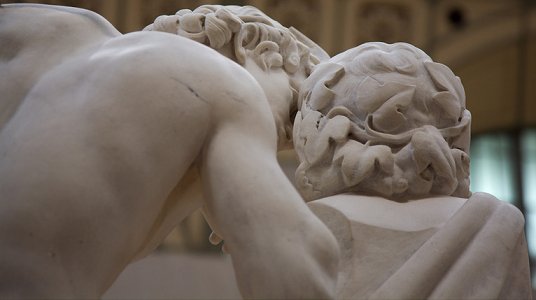
A marble copy in a park (can anybody tell me the location?)
and several bronzes with drapes and/or fig leaves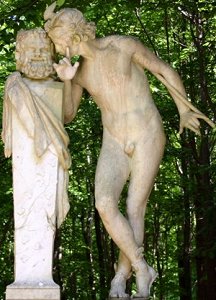
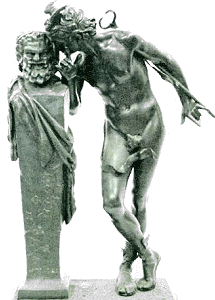
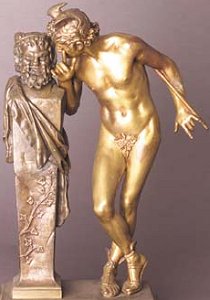
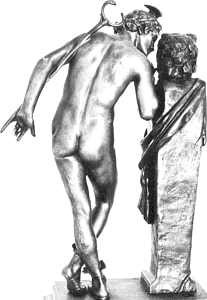
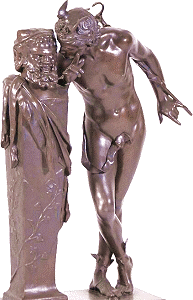
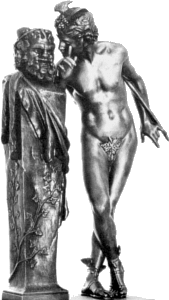
Une Trouvaille a Pompeii:
Original bronze in the Musée d’Orsay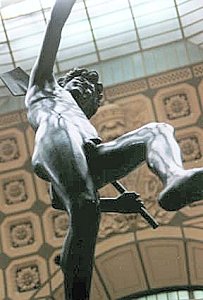
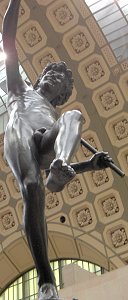

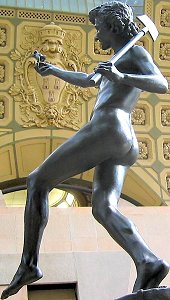

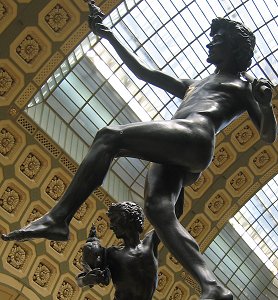
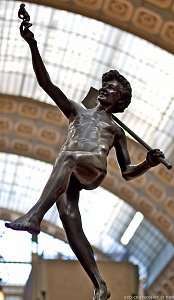

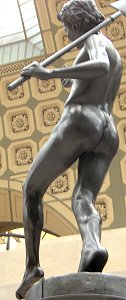
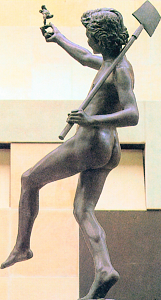
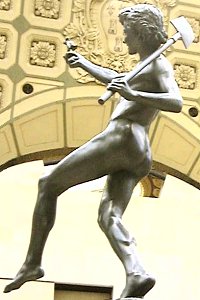
Biggish but dark images from Insecula (cached Wayback Machine versions):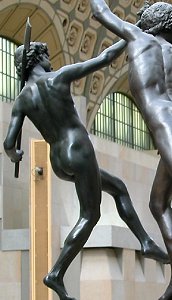

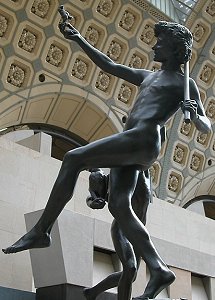
Original and statuette versions, front and front left views (book and webfinds)
1: Fig-leafed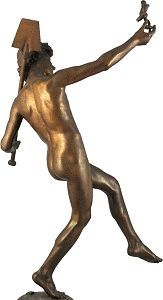

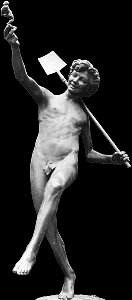
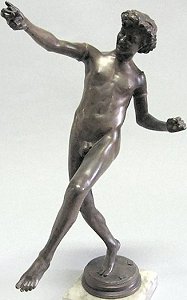
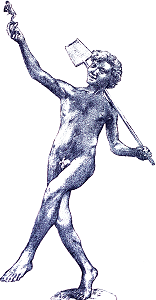
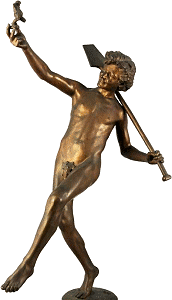
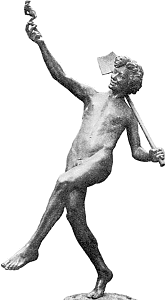

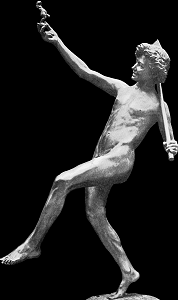
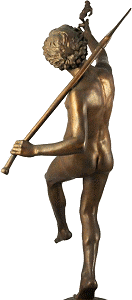
2: Bare-penised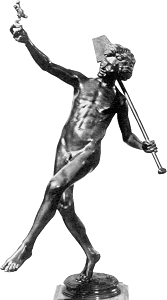
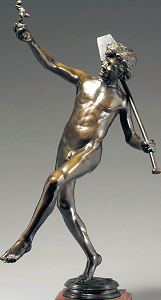
Comment on This Page | Artist Biography
Site Introduction | Art Gallery Index | Falguière and Moulin Page
Return to Top of Page



